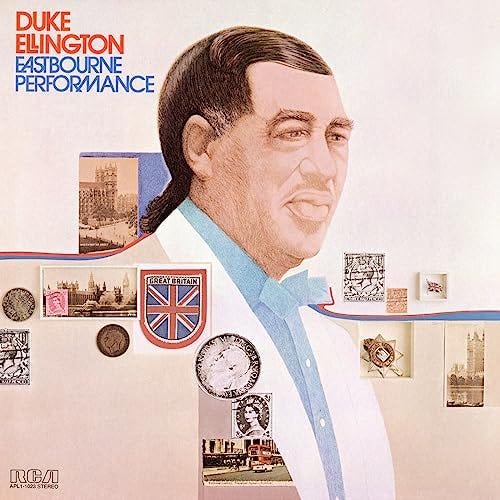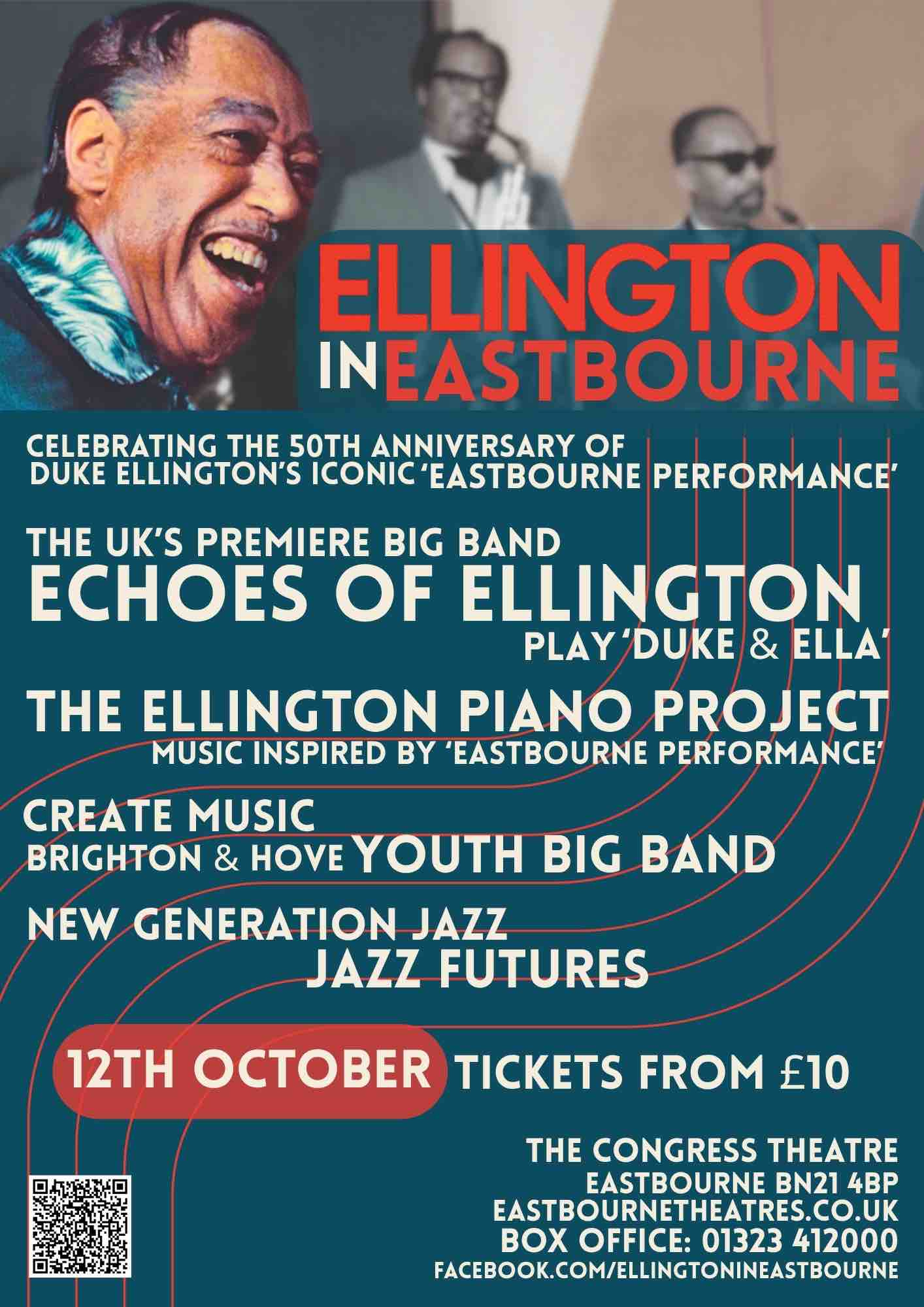Tone Parallel
Issue 17 August 2025
Did you attend Duke Ellington’s concert (two houses) in Eastbourne on 1 December 1973 or indeed any of the performances from the Ellington’s final visit to the UK and continental Europe?
If so, I would be delighted if you could contact me about your experience.
This coming October, a festival is being held to celebrate Ellington’s appearance at The Congress Theatre, Eastbourne and the fiftieth anniversary of the commercial release in 1975 of Ellington’s ‘last’ official album, Eastbourne Performance.
The event is being organized by bassist Arnie Somogyi and as part of the festivities the Congress Theatre foyer will feature an exhibition curated by Dr. Pedro Cravinho, archivist at the Duke Ellington Society UK, highlighting memories of the original concert at the Congress Theatre and its importance in Duke Ellington’s final European tour. Should any readers of this newsletter who attended those performances and who are willing to share their memories, it would be a very welcome contribution to the event.
A new album by Arnie Somogyi and pianist Mark Edwards will also be launched at the festival, of which more presently.
What is to be said of the ‘original’ album of Ellington’s Eastbourne performances? It is indeed performances in the plural since the selections on the album were drawn from both houses. Of course, for the Ellington enthusiast, nothing less than a double album of a complete performance or a boxed set of both performances would suffice. What has been released – firstly on the original album and then as part of RCA’s (as it then was) Centennial edition and the three CD set Live and Rare where the edition was ‘expanded’ by the inclusion of the track Metcuria The Lion – gives some of the flavour of this “valedictory” performance.
In terms of the full concert programme, I find, perhaps appropriately enough, crosscurrents or echoes of forty years earlier, in the tour of 1933, and indeed the situation Ellington found himself in twenty years earlier in 1953. Issues here help to determine what was presented on the south coast of England.
In an earlier essay on Ellington’s Royal Command Performance, Vaudeville is the Place, Man , I made the point that one aspect of Ellington’s work, and a significant aspect at that, was as an entertainer. His antipathy to the use of the word ‘jazz’ was not as marked in 1933, but his attitude had always been “You just have to go out and do a performance and if the performance believable they respond; if it’s acrobatic they respond; if it’s sensuous they respond and that’s all we can depend upon.” The reliance on singers, principally here Anita Moore and Toney Watkins is an aspect of the need to entertain and to be aware of contemporary styles as Ellington always had been in his choice of vocalist. Similarly, the ‘turn’ given by Money Johnson and his Louis Armstrong impression is another manifestation of the need to offer a varied programme. This particular turn did not always go down very well. Of a performance days earlier in Preston, Lancashire, the critic Peter Gardner wrote “There was also a low point. Trumpeter Harold ‘Money’ Johnson gave us an Armstrong-like version of Hello Dolly, which wasn’t terribly good. It was part of the concert where a jocular Ellington predicted what music would be around in the coming centuries. I have never fathomed why the Duke himself or anyone who played with him needed to move outside the Ellington-Strayhorn songbook for inspirational material. And predicting what future generations would be listening to seemed an ideal opportunity to be optimistic and play something Ellingtonian.”
This to miss the point rather. Ellington had always considered himself a “primitive” artist which he defined as someone who worked with the materials closest to hand – in this case, the musicians in the band. Concerts were chiefly an opportunity for these musicians to take up their “solo responsibilities”, Ellington presenting them as a chef cuisinier might present a new dish, a top designer present a new runway show or a ringmaster running his circus. Money Johnson could solo and sing. It was a case of do the math.
This brings me to the echoes of 1953–ish. Since the famous Newport Festival appearance, Ellington had enjoyed a pretty stable personnel in the band for well over a dozen years. In the immediate years before, with the departure of Sonny Greer, Johnny Hodges and Lawrence Brown and the semi-sabbatical of Strayhorn, the orchestra personnel was in a state of flux to some extent. As the sixties gave way to the seventies, three of those same personnel – Billy Strayhorn, Johnny Hodges and Lawrence Brown – were no longer present. Jimmy Hamilton had left the band and so too had Cootie Williams and Cat Anderson. To compound the difficulties for much of the UK leg of Ellington’s final European tour, Paul Gonsalves was absent through illness. Again, the band was in a state of flux with newer members of the orchestra such as trombonists Art Baron and Vince Prudente and trumpeter Barrie Lee Hall Jr not having been within the ranks for long. And unfortunately, Ellington simply would not live long enough this time for the Orchestra to evolve and reach the sort of fulfillment of its promise that had happened in 1956 and Newport. Even the limited time the newer members of the orchestra necessarily had under Ellington’s tutelage, that such an evolution would take place is in doubt. Just a short time under Ellington’s spell can be a life-long influence as Vince Prudente proves in his autobiography The Essence and Duke Ellington which is recommended reading.
All of these factors then are present in the Orchestra’s programme for Eastbourne and reflected up to a point in what made the final cut on the album. I don’t know who ‘produced’ the RCA album – Mercer, perhaps? RCA executives? Looking at the full list of titles the orchestra played that afternoon and evening of 1 December, My Mother, My Father And Love from My People sung by Toney Watkins would have been a fitting inclusion to this ‘last’ album. Interesting too to hear In Triplicate ‘downsized’ here to In Duplicate due to the absence of Paul Gonsalves. Ellington’s latest works were always integral to any of Duke’s concerts so the inclusion of Chinoiserie would have been welcome, the album still unreleased at that point. We did at least get SoSo from The Togo Brava Suite, although mis-titled on the original and all subsequent issues as Woods.
We can remedy these excisions up to a point with an extract from the evening performance which was not included on the album. This extract is taken from one of the Danish broadcasts of the 1980s which drew upon the ‘stockpile’ of recordings Mercer Ellington donated. We hear Blem, with a vocal by Anita Moore, Chinoiserie and I Can’t Get Started with Harold Ashby, concluding with Basin Street Blues and Money Johnson.
In addition to the repertoire chosen and the personnel of the Orchestra at any given time, there is a third aspect, too, to the Ellington Orchestra’s final performances, much in evidence in the Eastbourne album. It is more than appropriate that the first track on the album is entitled The Piano Player. This is the way Ellington would mockingly refer to himself when introducing the band’s theme song, extending his arm in his position in front of the Orchestra s master of ceremonies and indicating the piano bench as “the newest member of our Orchestra, the piano player.” He would then stride across the stage and take up his position on the empty bench.
Ellington’s own piano playing, as a piano number solo or with the rhythm section, became more prominent in performance towards the end of his career. That is the case in the Eastbourne album. It is not just his solo work, here on compositions such as Meditation and Metcuria The Lion (the latter released on later ‘expanded’ versions of the album) but in his fills, accompaniments and elaborations elsewhere in the concert. This brings me to another exciting aspect of the forthcoming Eastbourne concerts and the release ahead of the festival of a new album. Festival organizer Arnie Somogyi has collaborated with pianist Mark Edwards on an album entitled The Ellington Piano Project. The album “ is centred around the last piano on which Ellington recorded. It draws on harmonies and improvised phrases heard on his final album, Eastbourne Performance, as inspiration for new compositions and spontaneous improvisations, alongside reimaginings of Ellington classics. The band features New York-based rising tenor star Gideon Tazelaar, trumpeter Chris Coull and drummer Matthew Holmes.”
Liner notes for the album have been written by award winning writer and tenor saxophonist Simon Spillett who writes: “Musical reimaginings these days so often mask the material they seek to champion. This album, however, does precisely the opposite, offering us a new view on a legend mapped a million different times already. In this its significance is as noteworthy as its brilliance.”
Music from the album will be played in the first half of the main concert on Sunday evening on the very piano Ellington himself played fifty-two years earlier.
More details about the Eastbourne engagement can be found here.




Thanks for this music, Ian. It’s especially great to hear another “Chinoiserie” and another “I Can’t Get Started.”
The intros to “Basin Street Blues,” especially the longer one on the Eastbourne LP, make me think that somewhere along the way Duke and company must have heard the Art Ensemble of Chicago.